Affordances of Technology for Sustainability-Oriented K–12 Informal Engineering Education
Abstract
1. Introduction
2. Motivation
3. Approach
Framework
4. Cases
4.1. Augmented Reality
Example of Implementation
4.2. Virtual Reality
Example of Implementation
4.3. Video Games
Example of Implementation
4.4. Computer-Aided Design
Example of Implementation
4.5. Physical Computing
Example of Implementation
5. Discussion
5.1. Impact of AR on Sustainability-Oriented Engineering Education
Drawbacks and Future Research Directions for Augmented Reality in Education
5.2. Impact of Virtual Reality in Education
Drawbacks and Future Research Directions for Virtual Reality in Education
5.3. Impact of Video Games in Education
Drawbacks and Future Research Directions for Video Games in Education
5.4. Impact of Computer-Aided Design in Education
Drawbacks and Future Research Direction of Computer-Aided Design in Education
5.5. Impact of Physical Computing in Education
Drawbacks and Future Research Direction for Physical Computing in Education
6. Conclusions
7. Limitations
8. Recommendations
Funding
Informed Consent Statement
Data Availability Statement
Conflicts of Interest
References
- Sokolowska, D.; De Meyere, J.; Folmer, E.; Rovsek, B.; Peeters, W. Balancing the Needs between Training for Future Scientists and Broader Societal Needs—SECURE Project Research on Mathematics, Science and Technology Curricula and Their Implementation. Sci. Educ. Int. 2014, 25, 40–51. [Google Scholar]
- Filippi, A.; Agarwal, D. Teachers from Instructors to Designers of Inquiry-Based Science, Technology, Engineering, and Mathematics Education: How Effective Inquiry-Based Science Education Implementation Can Result in Innovative Teachers and Students. Sci. Educ. Int. 2017, 28, 258–270. [Google Scholar]
- Sullivan, A.; Bers, M.U. Dancing robots: Integrating art, music, and robotics in Singapore’s early childhood centers. Int. J. Technol. Des. Educ. 2018, 28, 325–346. [Google Scholar] [CrossRef]
- Van Meeteren, B.D. The importance of developing engineering habits of mind in early engineering education. In Early Engineering Learning; Springer: Singapore, 2018; pp. 37–52. [Google Scholar]
- Hegarty, K.; Thomas, I.; Kriewaldt, C.; Holdsworth, S.; Bekessy, S. Insights into the value of a ‘stand-alone ’ course for sustainability education. Environ. Educ. Res. 2011, 17, 451–469. [Google Scholar] [CrossRef]
- Argento, D.; Einarson, D.; Mårtensson, L.; Persson, C.; Wendin, K.; Westergren, A. Integrating sustainability in higher education: A Swedish case. Int. J. Sustain. High. Educ. 2020, 21, 1131–1150. [Google Scholar] [CrossRef]
- Pollard, J.R.; Michel, J.O.; Simon, A.C.; Shriberg, M. Team-Teaching as a Promising Pathway toward Interdisciplinary Sustainability Competency Development. Sustainability 2023, 15, 11534. [Google Scholar] [CrossRef]
- Servant-Miklos, V.; Holgaard, J.E.; Kolmos, A. Sustainability Matters: The Evolution of Sustainability Awareness, Interest and Engagement in PBL Engineering Students. J. Probl. Based Learn. High. Educ. 2023, 11, 124–154. [Google Scholar] [CrossRef]
- Janakiraman, S.; Watson, S.L.; Watson, W.R.; Cheng, Z. Creating environmentally conscious engineering professionals through attitudinal instruction: A mixed methods study. J. Clean. Prod. 2021, 291, 125957. [Google Scholar] [CrossRef]
- Hermes, J.; Rimanoczy, I. Deep learning for a sustainability mindset. Int. J. Manag. Educ. 2018, 16, 460–467. [Google Scholar] [CrossRef]
- United Nations Development Programme. Available online: https://www.undp.org/ (accessed on 12 July 2024).
- Tejedor, G.; Rosas-Casals, M.; Segalas, J. Patterns and trends in engineering education in sustainability: A vision from relevant journals in the field. Int. J. Sustain. High. Educ. 2019, 20, 360–377. [Google Scholar] [CrossRef]
- Sandri, O.J. Threshold concepts, systems and learning for sustainability. Environ. Educ. Res. 2013, 19, 810–822. [Google Scholar] [CrossRef]
- Ku, O.; Chen, S.Y.; Wu, D.H.; Lao, A.C.; Chan, T.W. The effects of game-based learning on mathematical confidence and performance: High ability vs. low ability. J. Educ. Technol. Soc. 2014, 17, 65–78. [Google Scholar]
- National Research Council; Division of Behavioral, Social Sciences; Board on Science Education; Committee on Successful Out-of-School STEM Learning. Identifying and Supporting Productive STEM Programs in Out-of-School Settings; National Academies Press: Washington, DC, USA, 2015. [Google Scholar]
- Norris, L. Learning to teach using ICT in the secondary school. A companion to school experience. J. Interact. Media Educ. 2015, 2015, 11. [Google Scholar] [CrossRef][Green Version]
- Panjaburee, P.; Hwang, G.J.; Triampo, W.; Shih, B.Y. A multi-expert approach for developing testing and diagnostic systems based on the concept-effect model. Comput. Educ. 2010, 55, 527–540. [Google Scholar] [CrossRef]
- Pachler, N.; Evans, M.; Redondo, A.; Fisher, L. Learning to Teach Foreign Languages in the Secondary School: A Companion to School Experience; Routledge: Abington, UK, 2013. [Google Scholar]
- Kennewell, S.; Parkinson, J.; Tanner, H. (Eds.) Learning to Teach ICT in the Secondary School; Routledge/Falmer: Abingdon, UK, 2002. [Google Scholar]
- Bligh, D.A. What’s the Use of Lectures? Penguin: Harmondsworth, UK, 1972; pp. 21–43. [Google Scholar]
- Ramsden, P. Learning to Teach in Higher Education; Routledge: Abingdon, UK, 2003. [Google Scholar]
- Kember, D.; Kwan, K.P. Lecturers’ approaches to teaching and their relationship to conceptions of good teaching. Instr. Sci. 2000, 28, 469–490. [Google Scholar] [CrossRef]
- Deterding, S.; Dixon, D.; Khaled, R.; Nacke, L. From game design elements to gamefulness: Defining “gamification”. In Proceedings of the 15th International Academic MindTrek Conference: Envisioning Future Media Environments, Tampere, Finland, 28–30 September 2011; pp. 9–15. [Google Scholar]
- Chang, S.N.; Chen, W.L. Does visualize industries matter? A technology foresight of global Virtual Reality and Augmented Reality Industry. In Proceedings of the 2017 International Conference on Applied System Innovation (ICASI), Sapporo, Japan, 13–17 May 2017; IEEE: New York, NY, USA, 2017; pp. 382–385. [Google Scholar]
- Rosenberg, L.B. Augmented reality: Reflections at thirty years. In Proceedings of the Future Technologies Conference (FTC) 2021, Vancouver, BC, Canada, 28–29 November 2021; Springer International Publishing: Cham, Switzerland, 2022; Volume 1, pp. 1–11. [Google Scholar]
- Fitria, T.N. Augmented reality (AR) and virtual reality (VR) technology in education: Media of teaching and learning: A review. Int. J. Comput. Inf. Syst. (IJCIS) 2023, 4, 14–25. [Google Scholar]
- McNally, B.; de Andrade, B. Altered spaces: New ways of seeing and envisioning nature with Minecraft. Vis. Stud. 2022, 37, 175–182. [Google Scholar] [CrossRef]
- Hobbs, L.; Behenna, S. Engaging children from under-represented groups with STEM using Minecraft to link with the UN SDGs. ASE Prim. Sci. 2023, 177, 23. [Google Scholar]
- Harrison, M.; Gesthuizen, R. Shared regulatory planning in Minecraft. In Encyclopedia of Education and Information Technologies; Springer International Publishing: Cham, Switzerland, 2020; pp. 1484–1497. [Google Scholar]
- Minecraft. Minecraft Education Edition. Available online: https://education.minecraft.net/en-us (accessed on 12 July 2024).
- Doğan, A.; Kahraman, E. Pre-Service Science Teachers Experience with 3d Digital Design Technology. In GLOBETSonline: International Conference on Education, Technology and Science; GLOBETSonline: Kazakhstan, Turkey, 2020; p. 163. [Google Scholar]
- Mohapatra, B.N.; Mohapatra, R.K.; Jijnyasa, J.; Shruti, Z. Easy performance based learning of arduino and sensors through Tinkercad. Int. J. Open Inf. Technol. 2020, 8, 73–76. [Google Scholar]
- Cherry, M.T. Design … Print … Animate. Indiana Libr. 2016, 35, 13–17. [Google Scholar]
- Kuo, R.L.; Laiy, W.Y.; Kao, Y.H. Application of digital modeling in the elementary school digital dessert workshop. In Proceedings of the 2018 1st IEEE International Conference on Knowledge Innovation and Invention (ICKII), Jeju, Republic of Korea, 23–27 July 2018; IEEE: New York, NY, USA, 2018; pp. 165–167. [Google Scholar]
- Ng, O.L. Exploring the use of 3D computer-aided design and 3D printing for STEAM learning in mathematics. Digit. Exp. Math. Educ. 2017, 3, 257–263. [Google Scholar] [CrossRef]
- Madar, J.; Goldberg, A.; Lam, K. “Hour of code” from Virtual Reality. In Proceedings of the 23rd Western Canadian Conference on Computing Education 2018, Victoria, BC, Canada, 4–5 May 2018; pp. 1–7. [Google Scholar]
- Jones, A.; Buntting, C.; de Vries, M.J. The developing field of technology education: A review to look forward. Int. J. Technol. Des. Educ. 2013, 23, 191–212. [Google Scholar] [CrossRef]
- Garzón, J.; Pavón, J.; Baldiris, S. Systematic review and meta-analysis of augmented reality in educational settings. Virtual Real. 2019, 23, 447–459. [Google Scholar] [CrossRef]
- Jamei, E.; Mortimer, M.; Seyedmahmoudian, M.; Horan, B.; Stojcevski, A. Investigating the role of virtual reality in planning for sustainable smart cities. Sustainability 2017, 9, 2006. [Google Scholar] [CrossRef]
- Nadolny, L.; Valai, A.; Cherrez, N.J.; Elrick, D.; Lovett, A.; Nowatzke, M. Examining the characteristics of game-based learning: A content analysis and design framework. Comput. Educ. 2020, 156, 103936. [Google Scholar] [CrossRef]
- Kelley, T.R.; Knowles, J.G. A conceptual framework for integrated STEM education. Int. J. STEM Educ. 2016, 3, 11. [Google Scholar] [CrossRef]
- Radu, I.; Antle, A. Embodied learning mechanics and their relationship to usability of handheld augmented reality. In Proceedings of the 2017 IEEE Virtual Reality Workshop on K–12 Embodied Learning through Virtual & Augmented Reality (KELVAR), Los Angeles, CA, USA, 19 March 2017; IEEE: New York, NY, USA, 2017; pp. 1–5. [Google Scholar]
- Yip, J.; Wong, S.H.; Yick, K.L.; Chan, K.; Wong, K.H. Improving quality of teaching and learning in classes by using augmented reality video. Comput. Educ. 2019, 128, 88–101. [Google Scholar] [CrossRef]
- Xu, W.W.; Su, C.Y.; Hu, Y.; Chen, C.H. Exploring the effectiveness and moderators of augmented reality on science learning: A meta-analysis. J. Sci. Educ. Technol. 2022, 31, 621–637. [Google Scholar] [CrossRef]
- Bacca Acosta, J.L.; Baldiris Navarro, S.M.; Fabregat Gesa, R.; Graf, S. Augmented reality trends in education: A systematic review of research and applications. J. Educ. Technol. Soc. 2014, 17, 133–149. [Google Scholar]
- Billinghurst, M.; Duenser, A. Augmented reality in the classroom. Computer 2012, 45, 56–63. [Google Scholar] [CrossRef]
- Akçayır, M.; Akçayır, G. Advantages and challenges associated with augmented reality for education: A systematic review of the literature. Educ. Res. Rev. 2017, 20, 1–11. [Google Scholar] [CrossRef]
- Cai, S.; Liu, C.; Wang, T.; Liu, E.; Liang, J.-C. Effects of learning physics using augmented reality on students’ self-efficacy and conceptions of learning. Interact. Learn. Environ. 2020; advance online publication. [Google Scholar]
- Altinpulluk, H. Determining the trends of using augmented reality in education between 2006–2016. Educ. Inf. Technol. 2019, 24, 1089–1114. [Google Scholar] [CrossRef]
- Küçük, S.; Kapakin, S.; Göktaş, Y. Learning anatomy via mobile augmented reality: Effects on achievement and cognitive load. Anat. Sci. Educ. 2016, 9, 411–421. [Google Scholar] [CrossRef] [PubMed]
- Huang, T.C.; Chen, C.C.; Chou, Y.W. Animating eco-education: To see, feel, and discover in an augmented reality-based experiential learning environment. Comput. Educ. 2016, 96, 72–82. [Google Scholar] [CrossRef]
- Garcia-Bonete, M.J.; Jensen, M.; Katona, G. A practical guide to developing virtual and augmented reality exercises for teaching structural biology. Biochem. Mol. Biol. Educ. 2019, 47, 16–24. [Google Scholar] [CrossRef] [PubMed]
- Hoog, T.G.; Aufdembrink, L.M.; Gaut, N.J.; Sung, R.J.; Adamala, K.P.; Engelhart, A.E. Rapid deployment of smartphone-based augmented reality tools for field and online education in structural biology. Biochem. Mol. Biol. Educ. 2020, 48, 448–451. [Google Scholar] [CrossRef]
- Fuchsova, M.; Korenova, L. Visualisation in Basic Science and Engineering Education of Future Primary School Teachers in Human Biology Education Using Augmented Reality. Eur. J. Contemp. Educ. 2019, 8, 92–102. [Google Scholar]
- Arslan, R.; Kofoğlu, M.; Dargut, C. Development of augmented reality application for biology education. J. Turk. Sci. Educ. 2020, 17, 62–72. [Google Scholar] [CrossRef]
- Celik, C.; Guven, G.; Cakir, N.K. Integration of mobile augmented reality (MAR) applications into biology laboratory: Anatomic structure of the heart. Res. Learn. Technol. 2020, 28. [Google Scholar] [CrossRef]
- Dominguez Alfaro, J.L.; Gantois, S.; Blattgerste, J.; De Croon, R.; Verbert, K.; Pfeiffer, T.; Van Puyvelde, P. Mobile augmented reality laboratory for learning acid–base titration. J. Chem. Educ. 2022, 99, 531–537. [Google Scholar] [CrossRef]
- Krug, M.; Huwer, J. Safety in the Laboratory—An Exit Game Lab Rally in Chemistry Education. Computers 2023, 12, 67. [Google Scholar] [CrossRef]
- Eriksen, K.; Nielsen, B.E.; Pittelkow, M. Visualizing 3D molecular structures using an augmented reality app. J. Chem. Educ. 2020, 97, 1487–1490. [Google Scholar] [CrossRef]
- Probst, C.; Fetzer, D.; Lukas, S.; Huwer, J. Effects of using augmented reality (AR) in visualizing a dynamic particle model. Chemkon 2022, 29, 164–170. [Google Scholar] [CrossRef]
- Syskowski, S.; Huwer, J. A Combination of Real-World Experiments and Augmented Reality When Learning about the States of Wax—An Eye-Tracking Study. Educ. Sci. 2023, 13, 177. [Google Scholar] [CrossRef]
- Tschiersch, A.; Krug, M.; Huwer, J.; Banerji, A. Augmented Reality in chemistry education—An overview. Chemkon 2021, 28, 241–244. [Google Scholar] [CrossRef]
- Tee NY, K.; Gan, H.S.; Li, J.; Cheong BH, P.; Tan, H.Y.; Liew, O.W.; Ng, T.W. Developing and demonstrating an augmented reality colorimetric titration tool. J. Chem. Educ. 2018, 95, 393–399. [Google Scholar] [CrossRef]
- Martín-Gutiérrez, J.; Roca González, C.; García Domínguez, M. Training of spatial ability on engineering students through a remedial course based on augmented reality. In Proceedings of the International Design Engineering Technical Conferences and Computers and Information in Engineering Conference, Chicago, IL, USA, 12–15 August 2012; American Society of Mechanical Engineers: New York, NY, USA, 2012; Volume 45066, pp. 219–225. [Google Scholar]
- Sheharyar, A.; Srinivasa, A.R.; Masad, E. Enhancing 3-D spatial skills of engineering students using augmented reality. In Proceedings of the 2020 ASEE Virtual Annual Conference Content Access, Virtual Online, 22–26 June 2020. [Google Scholar]
- Cazzolla, A.; Lanzilotti, R.; Roselli, T.; Rossano, V. Augmented reality to support education in industry 4.0. In Proceedings of the 2019 18th International Conference on Information Technology Based Higher Education And Training (ITHET), Magdeburg, Germany, 26–27 September 2019; IEEE: New York, NY, USA, 2019; pp. 1–5. [Google Scholar]
- Sahin, C.; Nguyen, D.; Begashaw, S.; Katz, B.; Chacko, J.; Henderson, L.; Stanford, J.; Dandekar, K.R. Wireless communications engineering education via Augmented Reality. In Proceedings of the 2016 IEEE Frontiers in Education Conference (FIE), Erie, PA, USA, 12–15 October 2016; IEEE: New York, NY, USA, 2019; pp. 1–7. [Google Scholar]
- Martín-Gutiérrez, J.; Contero, M. Improving academic performance and motivation in engineering education with augmented reality. In Proceedings of the HCI International 2011–Posters’ Extended Abstracts: International Conference, HCI International 2011, Orlando, FL, USA, 9–14 July 2011; Proceedings, Part II 14. Springer: Berlin/Heidelberg, Germany, 2011; pp. 509–513. [Google Scholar]
- Kang, E.; Yan, S.; Katz, A.; Hira, A. Augmented Reality for Sustainable Collaborative Design. In Proceedings of the 2022 ASEE Annual Conference & Exposition, Minneapolis, MN, USA, 25–29 June 2022. [Google Scholar]
- Beheshti, M.; Yujin Kang, E.; Yan, S.; Louime, E.; Hancock, C.; Hira, A. Augmented Reality in A Sustainable Engineering Design Context: Understanding Students’ Collaboration and Negotiation Practices. Sustainability 2023, 16, 379. [Google Scholar] [CrossRef]
- Al-Gindy, A.; Felix, C.; Ahmed, A.; Matoug, A.; Alkhidir, M. Virtual reality: Development of an integrated learning environment for education. Int. J. Inf. Educ. Technol. 2020, 10, 171–175. [Google Scholar] [CrossRef]
- McGee, B.L.; Jacka, L. Virtual reality in Education. Broken promises or new hope? In ASCILITE 2021 Conference Proceedings: Back to the Future; ASCILITE Publications: Melbourne, Australia, 2021; pp. 74–80. [Google Scholar]
- Taxén, G.; Naeve, A. A system for exploring open issues in VR-based education. Comput. Graph. 2002, 26, 593–598. [Google Scholar] [CrossRef]
- Sampaio, A.Z.; Ferreira, M.M.; Rosário, D.P.; Martins, O.P. 3D and VR models in Civil Engineering education: Construction, rehabilitation and maintenance. Autom. Constr. 2010, 19, 819–828. [Google Scholar] [CrossRef]
- Corcoran, J.; Zahnow, R.; Assemi, B. Wander: A smartphone APP for sensing sociability. Appl. Spat. Anal. Policy 2018, 11, 537–556. [Google Scholar] [CrossRef]
- Zolyomi, A.; Schmalz, M. Mining for social skills: Minecraft in home and therapy for neurodiverse youth. In Proceedings of the 50th Hawaii International Conference on System Sciences, Hilton Waikoloa Village, HI, USA, 4–7 January 2017. [Google Scholar]
- Overby, A.; Jones, B.L. Virtual LEGOs: Incorporating Minecraft into the art education curriculum. Art Educ. 2015, 68, 21–27. [Google Scholar] [CrossRef]
- Niemeyer, D.J.; Gerber, H.R. Maker culture and Minecraft: Implications for the future of learning. Educ. Media Int. 2015, 52, 216–226. [Google Scholar] [CrossRef]
- Andersen, R.; Rustad, M. Using Minecraft as an educational tool for supporting collaboration as a 21st century skill. Comput. Educ. Open 2022, 3, 100094. [Google Scholar] [CrossRef]
- Baek, Y.; Min, E.; Yun, S. Mining educational implications of Minecraft. Comput. Sch. 2020, 37, 1–16. [Google Scholar] [CrossRef]
- Blanco-Herrera, J.A.; Gentile, D.A.; Rokkum, J.N. Video games can increase creativity, but with caveats. Creat. Res. J. 2019, 31, 119–131. [Google Scholar] [CrossRef]
- Callaghan, N. Investigating the role of Minecraft in educational learning environments. Educ. Media Int. 2016, 53, 244–260. [Google Scholar] [CrossRef]
- Karsenti, T.; Bugmann, J. Exploring the Educational Potential of Minecraft: The Case of 118 Elementary-School Students; International Association for Development of the Information Society: Lisbon, Portugal, 2017. [Google Scholar]
- Nebel, S.; Schneider, S.; Rey, G.D. Mining learning and crafting scientific experiments: A literature review on the use of minecraft in education and research. J. Educ. Technol. Soc. 2016, 19, 355–366. [Google Scholar]
- Al-Washmi, R.; Bana, J.; Knight, I.; Benson, E.; Kerr OA, A.; Blanchfield, P.; Hopkins, G. Design of a math learning game using a Minecraft mod. In Proceedings of the European Conference on Games Based Learning, Berlin, Germany, 9–10 October 2014; Academic Conferences International Limited: Reading, UK, 2014; Volume 1, p. 10. [Google Scholar]
- Pusey, M.; Pusey, G. Using Minecraft in the science classroom. Int. J. Innov. Sci. Math. Educ. 2015, 23, 22–34. [Google Scholar]
- Garcia Martinez, S. Using Commercial Games to Support Teaching in Higher Education. Ph.D. Thesis, Concordia University, Mequon, WI, USA, 2014. [Google Scholar]
- West, D.M.; Bleiberg, J. Education Technology Success Stories; The Brookings Institution: Washington, DC, USA, 2013. [Google Scholar]
- Marcon, N.; Faulkner, J. Exploring Minecraft as a pedagogy to motivate girls’ literacy practices in the secondary English classroom. Engl. Aust. 2016, 51, 63–69. [Google Scholar]
- Carbonell-Carrera, C.; Jaeger, A.J.; Saorín, J.L.; Melián, D.; De la Torre-Cantero, J. Minecraft as a block building approach for developing spatial skills. Entertain. Comput. 2021, 38, 100427. [Google Scholar] [CrossRef]
- Bebbington, S.; Vellino, A. Can playing Minecraft improve teenagers’ information literacy? J. Inf. Lit. 2015, 9, 6–26. [Google Scholar] [CrossRef]
- Hjorth, L.; Richardson, I.; Davies, H.; Balmford, W. Exploring Minecraft: Ethnographies of Play and Creativity; Springer Nature: Cham, Switzerland, 2021. [Google Scholar]
- Nguyen, J. Minecraft and the building blocks of creative individuality. Configurations 2016, 24, 471–500. [Google Scholar] [CrossRef]
- Pakman, A.; Pakman, N.; Samur, Y. The Effects of Coding, Robotics, 3d Design and Game Design Education on 21st Century Skills of Primary School Students. Turk. Online J. Educ. Technol. 2023, 22, 109–152. [Google Scholar]
- Somyurek, S. The new trends in adaptive educational hypermedia systems. Int. Rev. Res. Open Distrib. Learn. 2015, 16, 221–241. [Google Scholar] [CrossRef]
- Blikstein, P. Digital fabrication and ‘making’in education: The democratization of invention. FabLabs Mach. Mak. Invent. 2013, 4, 1–21. [Google Scholar]
- Smith, C.F.; Tollemache, N.; Covill, D.; Johnston, M. Take away body parts! An investigation into the use of 3D-printed anatomical models in undergraduate anatomy education. Anat. Sci. Educ. 2018, 11, 44–53. [Google Scholar] [CrossRef]
- Baudisch, P.; Mueller, S. Personal fabrication: State of the art and future research. In Proceedings of the 2016 CHI Conference Extended Abstracts on Human Factors in Computing Systems, San Jose, CA, USA, 7–12 May 2016; pp. 936–939. [Google Scholar]
- Bhaduri, S.; Ortiz Tovar, J.G.; Kane, S.K. Fabrication games: Using 3D printers to explore new interactions for tabletop games. In Proceedings of the 2017 ACM SIGCHI Conference on Creativity and Cognition, Singapore, 27–30 June 2017; pp. 51–62. [Google Scholar]
- Ford, S.; Minshall, T. Invited review article: Where and how 3D printing is used in teaching and education. Addit. Manuf. 2019, 25, 131–150. [Google Scholar] [CrossRef]
- Posch, I.; Fitzpatrick, G. First steps in the FabLab: Experiences engaging children. In Proceedings of the 24th Australian Computer-Human Interaction Conference, Melbourne, Australia, 26–30 November 2012; pp. 497–500. [Google Scholar]
- Goyanes, A.; Kobayashi, M.; Martínez-Pacheco, R.; Gaisford, S.; Basit, A.W. Fused-filament 3D printing of drug products: Microstructure analysis and drug release characteristics of PVA-based caplets. Int. J. Pharm. 2016, 514, 290–295. [Google Scholar] [CrossRef]
- Hodges, S.; Sentance, S.; Finney, J.; Ball, T. Physical computing: A key element of modern computer science education. Computer 2020, 53, 20–30. [Google Scholar] [CrossRef]
- Shah, A.; Park, J.H.; Raphael, D.; Beheshti, M.; Phatak, J.U.; Sun, C.; Hira, A.; Zhang, H.; Barnett, M. Dynamics of Interest and Competency Belief in Coding among Middle-schoolers. In Proceedings of the 18th International Conference of the Learning Sciences-ICLS 2024, Buffalo, NY, USA, 10–14 June 2024; pp. 1586–1589. [Google Scholar]
- Dunleavy, M.; Dede, C.; Mitchell, R. Affordances and limitations of immersive participatory augmented reality simulations for teaching and learning. J. Sci. Educ. Technol. 2009, 18, 7–22. [Google Scholar] [CrossRef]
- Lindgren, R.; Tscholl, M.; Wang, S.; Johnson, E. Enhancing learning and engagement through embodied interaction within a mixed reality simulation. Comput. Educ. 2016, 95, 174–187. [Google Scholar] [CrossRef]
- Vygotsky, L.S.; Cole, M. Mind in Society: Development of Higher Psychological Processes; Harvard University Press: Cambridge, MA, USA, 1978. [Google Scholar]
- Weintrop, D.; Beheshti, E.; Horn, M.; Orton, K.; Jona, K.; Trouille, L.; Wilensky, U. Defining computational thinking for mathematics and science classrooms. J. Sci. Educ. Technol. 2016, 25, 127–147. [Google Scholar] [CrossRef]
- Milgram, P.; Kishino, F. A taxonomy of mixed reality visual displays. IEICE Trans. Inf. Syst. 1994, 77, 1321–1329. [Google Scholar]
- Sommerauer, P.; Müller, O. Augmented reality in informal learning environments: A field experiment in a mathematics exhibition. Comput. Educ. 2014, 79, 59–68. [Google Scholar] [CrossRef]
- Chang, K.E.; Chang, C.T.; Hou, H.T.; Sung, Y.T.; Chao, H.L.; Lee, C.M. Development and behavioral pattern analysis of a mobile guide system with augmented reality for painting appreciation instruction in an art museum. Comput. Educ. 2014, 71, 185–197. [Google Scholar] [CrossRef]
- Vega-Gorgojo, G.; Asensio-Perez, J.I.; Gomez-Sanchez, E.; Bote-Lorenzo, M.L.; Muñoz-Cristóbal, J.A.; Ruiz-Calleja, A. A Review of Linked Data Proposals in the Learning Domain. J. Univers. Comput. Sci. 2015, 21, 326–364. [Google Scholar]
- Cheng, K.H.; Tsai, C.C. Affordances of augmented reality in science learning: Suggestions for future research. J. Sci. Educ. Technol. 2013, 22, 449–462. [Google Scholar] [CrossRef]
- Chiang, T.H.; Yang, S.J.; Hwang, G.J. An augmented reality-based mobile learning system to improve students’ learning achievements and motivations in natural science inquiry activities. J. Educ. Technol. Soc. 2014, 17, 352–365. [Google Scholar]
- Sedlák, M.; Šašinka, Č.; Stachoň, Z.; Chmelík, J.; Doležal, M. Collaborative and individual learning of geography in immersive virtual reality: An effectiveness study. PLoS ONE 2022, 17, e0276267. [Google Scholar] [CrossRef]
- Cho, Y.; Park, K.S. Designing immersive virtual reality simulation for environmental science education. Electronics 2023, 12, 315. [Google Scholar] [CrossRef]
- Wu, J.; Guo, R.; Wang, Z.; Zeng, R. Integrating spherical video-based virtual reality into elementary school students’ scientific inquiry instruction: Effects on their problem-solving performance. Interact. Learn. Environ. 2021, 29, 496–509. [Google Scholar] [CrossRef]
- Zhao, D.; Lucas, J. Virtual reality simulation for construction safety promotion. Int. J. Inj. Control Saf. Promot. 2015, 22, 57–67. [Google Scholar] [CrossRef] [PubMed]
- Li, H.; Zhang, X.; Wang, H.; Yang, Z.; Liu, H.; Cao, Y.; Zhang, G. Access to nature via virtual reality: A mini-review. Front. Psychol. 2021, 12, 725288. [Google Scholar] [CrossRef]
- Scurati, G.W.; Bertoni, M.; Graziosi, S.; Ferrise, F. Exploring the use of virtual reality to support environmentally sustainable behavior: A framework to design experiences. Sustainability 2021, 13, 943. [Google Scholar] [CrossRef]
- Bahrin, A.S.; Sunar, M.S.; Azman, A. Enjoyment as gamified experience for informal learning in virtual reality. In Proceedings of the International Conference on Intelligent Technologies for Interactive Entertainment, Virtual Event, 3–4 December 2021; Springer International Publishing: Cham, Switzerland, 2021; pp. 383–399. [Google Scholar]
- Cliffe, A.D. A review of the benefits and drawbacks to virtual field guides in today’s geoscience higher education environment. Int. J. Educ. Technol. High. Educ. 2017, 14, 28. [Google Scholar] [CrossRef]
- Radianti, J.; Majchrzak, T.A.; Fromm, J.; Wohlgenannt, I. A systematic review of immersive virtual reality applications for higher education: Design elements, lessons learned, and research agenda. Comput. Educ. 2020, 147, 103778. [Google Scholar] [CrossRef]
- Keenaghan, G.; Horváth, I. State of the Art of Using Virtual Reality Technologies in Built Environment Education. In Proceedings of the TMCE 2014, Budapest, Hungary, 19–23 May 2014. [Google Scholar]
- Nguyen, H.A.; Else-Quest, N.; Richey, J.E.; Hammer, J.; Di, S.; McLaren, B.M. Gender differences in learning game preferences: Results using a multi-dimensional gender framework. In Proceedings of the International Conference on Artificial Intelligence in Education 2023, Tokyo, Japan, 3–7 July 2023; Springer Nature: Cham, Switzerland, 2023; pp. 553–564. [Google Scholar]
- Suprapto, N.; Hidaayatullaah, H.N.; Mubarok, H. Trend and research of Lego and Minecraft as learning media to realize 4th SDGs. In Proceedings of the E3S Web of Conferences, Surabaya, Indonesia, 3–4 October 2023; EDP Sciences: Les Ulis, France, 2023; Volume 450, p. 01003. [Google Scholar]
- Kersánszki, T.; Márton, Z.; Fenyvesi, K.; Lavicza, Z.; Holik, I. Minecraft in STEAM education-applying game-based learning to renewable energy. Interact. Des. Arch. 2024, 194–213. [Google Scholar] [CrossRef]
- Opmeer, M.; Dias, E.; De Vogel, B.; Tangerman, L.; Scholten, H.J. Minecraft in support of teaching sustainable spatial planning in secondary education. In Proceedings of the 10th International Conference on Computer Supported Education, Madeira, Portugal, 15–17 March 2018; pp. 316–321. [Google Scholar]
- Short, D. Teaching scientific concepts using a virtual world—Minecraft. Teach. Sci.-J. Aust. Sci. Teach. Assoc. 2012, 58, 55. [Google Scholar]
- Ruotsalainen, H. Designing Educational Game Experiences for k12 Students in Context of Informal Minecraft Club. Master’s Thesis, University of OULU, Oulu, Finland, 2016. [Google Scholar]
- Bhaduri, S.; Biddy, Q.L.; Bush, J.; Suresh, A.; Sumner, T. 3DnST: A framework towards understanding children’s interaction with Tinkercad and enhancing spatial thinking skills. In Proceedings of the 20th Annual ACM Interaction Design and Children Conference, Athens, Greece, 24–30 June 2021; pp. 257–267. [Google Scholar]
- Eryilmaz, S.; Deniz, G. Effect of Tinkercad on Students’ Computational Thinking Skills and Perceptions: A Case of Ankara Province. Turk. Online J. Educ. Technol. 2021, 20, 25–38. [Google Scholar]
- Kell, H.J.; Lubinski, D.; Benbow, C.P.; Steiger, J.H. Creativity and technical innovation: Spatial ability’s unique role. Psychol. Sci. 2013, 24, 1831–1836. [Google Scholar] [CrossRef] [PubMed]
- Bhaduri, S.; Van Horne, K.; Sumner, T. Designing an informal learning curriculum to develop 3D modeling knowledge and improve spatial thinking skills. In Proceedings of the Extended Abstracts of the 2019 CHI Conference on Human Factors in Computing Systems, Glasgow, UK, 4–9 May 2019; pp. 1–8. [Google Scholar]
- Thornburg, D.; Thornburg, N.; Armstrong, S. The pros and cons of 3D printing. Tech. Learn. 2014, 35, 22–24. [Google Scholar]
- Kostakis, V.; Niaros, V.; Dafermos, G.; Bauwens, M. Design global, manufacture local: Exploring the contours of an emerging productive model. Futures 2015, 73, 126–135. [Google Scholar] [CrossRef]
- Papert, S.; Harel, I. Situating constructionism. Constructionism 1991, 36, 1–11. [Google Scholar]
- Sentance, S.; Schwiderski-Grosche, S. Challenge and creativity: Using. NET gadgeteer in schools. In Proceedings of the 7th Workshop in Primary and Secondary Computing Education, Hamburg, Germany, 8–9 November 2012; pp. 90–100. [Google Scholar]
- Kafai, Y.B.; Lee, E.; Searle, K.; Fields, D.; Kaplan, E.; Lui, D. A crafts-oriented approach to computing in high school: Introducing computational concepts, practices, and perspectives with electronic textiles. ACM Trans. Comput. Educ. (TOCE) 2014, 14, 1–20. [Google Scholar] [CrossRef]
- Kaloti-Hallak, F.; Armoni, M.; Ben-Ari, M. Students’ attitudes and motivation during robotics activities. In Proceedings of the Workshop in Primary and Secondary Computing Education, London, UK, 9–11 November 2015; pp. 102–110. [Google Scholar]
- Rubio, M.A.; Romero-Zaliz, R.; Mañoso, C.; de Madrid, A.P. Closing the gender gap in an introductory programming course. Comput. Educ. 2015, 82, 409–420. [Google Scholar] [CrossRef]
- Voštinár, P. Pythagorean theorem-mobile application. In INTED2018 Proceedings; IATED: Valencia, Spain, 2018; pp. 800–805. [Google Scholar]
- Voštinár, P. Creating mobile apps for teaching. In INTED2018 Proceedings; IATED: Valencia, Spain, 2018; pp. 811–816. [Google Scholar]
- Voštinár, P.; Hanzel, P. Mobile application–a tool for teachers, pupils and their families. In Proceedings of the APLIMAT 2016–15th Conference on Applied Mathematics, Bratislava, Slovak Republic, 2–4 February 2016; pp. 1118–1125. [Google Scholar]
- Jin, K.H.; Eglowstein, H.; Sabin, M. Using physical computing projects in teaching introductory programming. In Proceedings of the 19th Annual Sig Conference on Information Technology Education, Fort Lauderdale, FL, USA, 3–6 October 2018; p. 155. [Google Scholar]
- Sentance, S.; Waite, J.; Hodges, S.; MacLeod, E.; Yeomans, L. “Creating Cool Stuff” Pupils’ Experience of the BBC micro: Bit. In Proceedings of the 2017 ACM SIGCSE Technical Symposium on Computer Science Education, Seattle, WA, USA, 8–11 March 2017; pp. 531–536. [Google Scholar]
- Hodges, S.; Scott, J.; Sentance, S.; Miller, C.; Villar, N.; Schwiderski-Grosche, S.; Hammil, K.; Johnston, S. NET Gadgeteer: A new platform for K-12 computer science education. In Proceeding of the 44th ACM Technical Symposium on Computer Science Education, Denver, CO, USA, 6–9 March 2013; pp. 391–396. [Google Scholar]
- Parsons, D.; MacCallum, K. Investigating the Classroom Environment from Physical Computing. Int. J. Mob. Blended Learn. 2022, 14, 1–14. [Google Scholar] [CrossRef]
- Fitzgerald, S.; McCauley, R.; Hanks, B.; Murphy, L.; Simon, B.; Zander, C. Debugging from the student perspective. IEEE Trans. Educ. 2009, 53, 390–396. [Google Scholar] [CrossRef]
- Jeon, H.K.; Kim, Y.S. Design of Physical Computing Teaching-tool Based on Knowledge Structuralization in Software Education at Elementary and Secondary school. Korean Assoc. Comput. Educ. 2016, 20, 39–42. [Google Scholar]
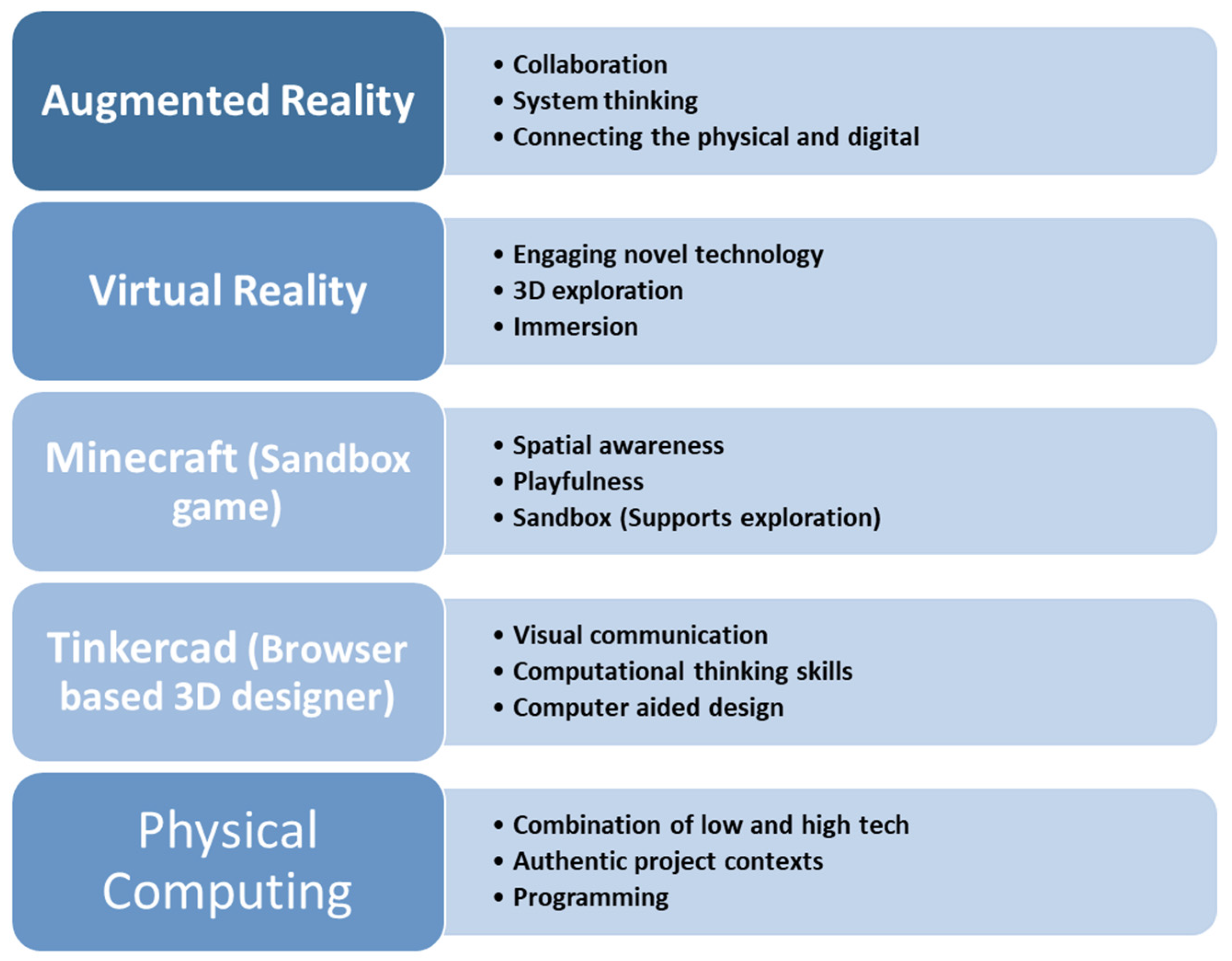


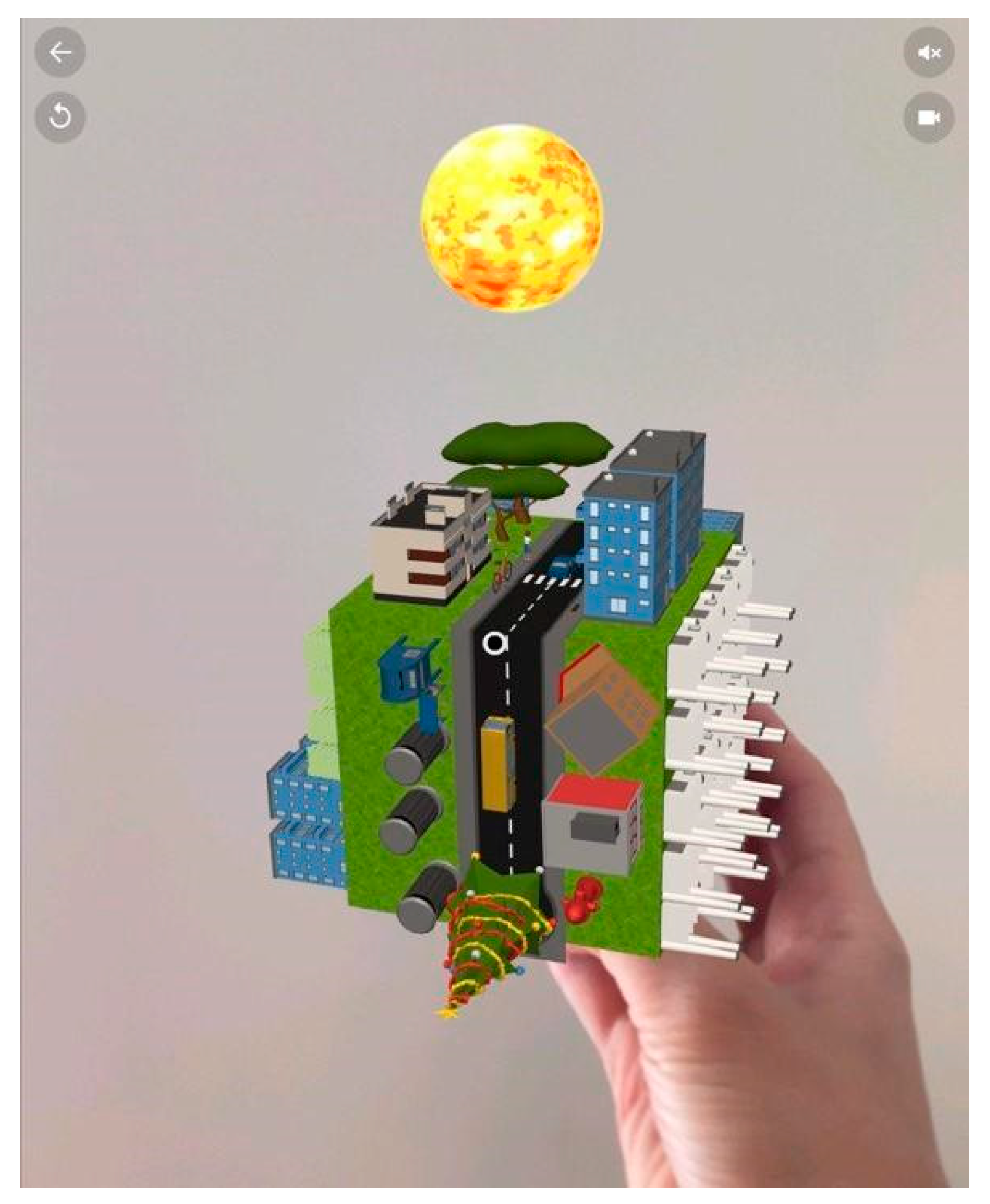
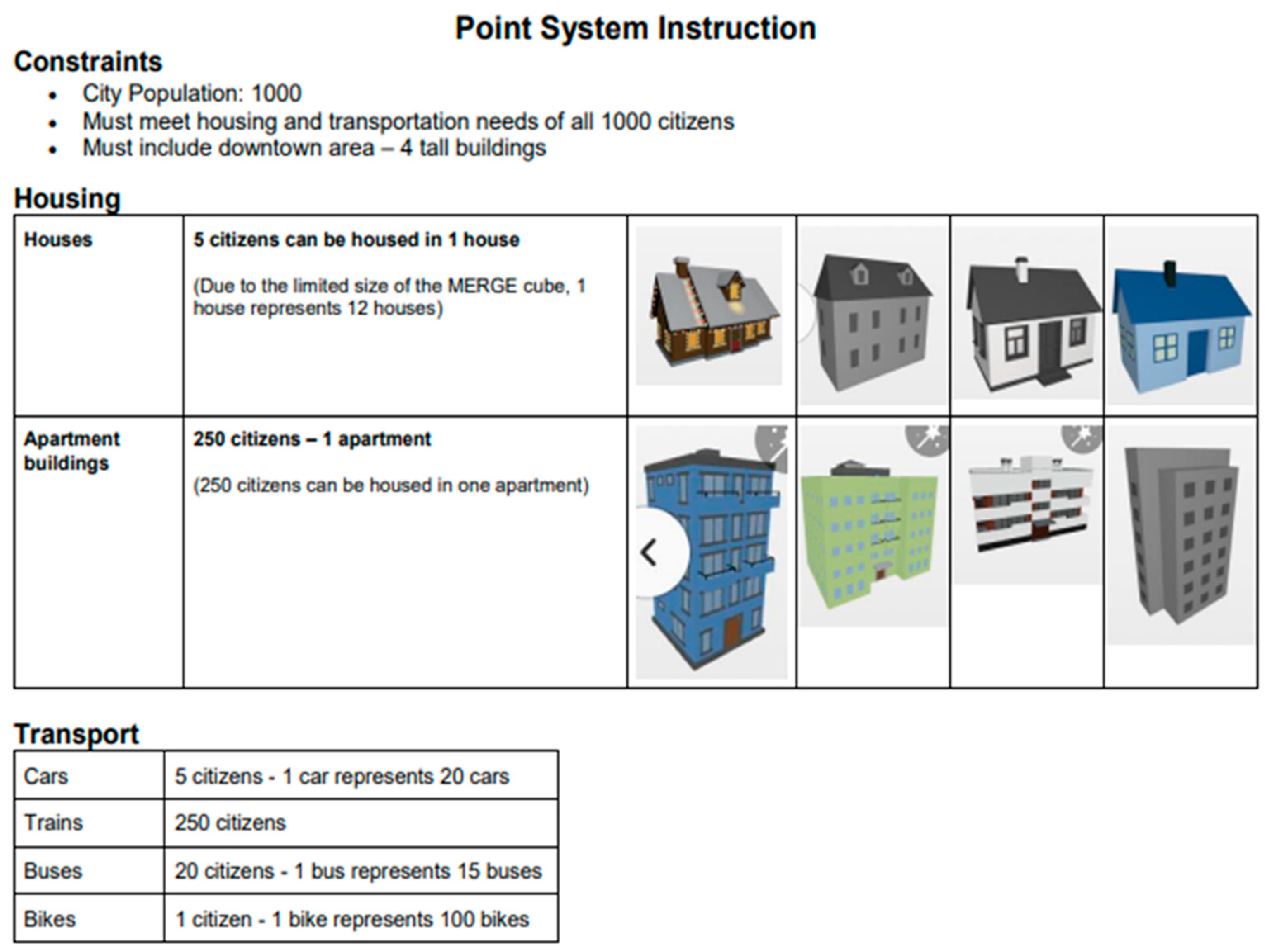



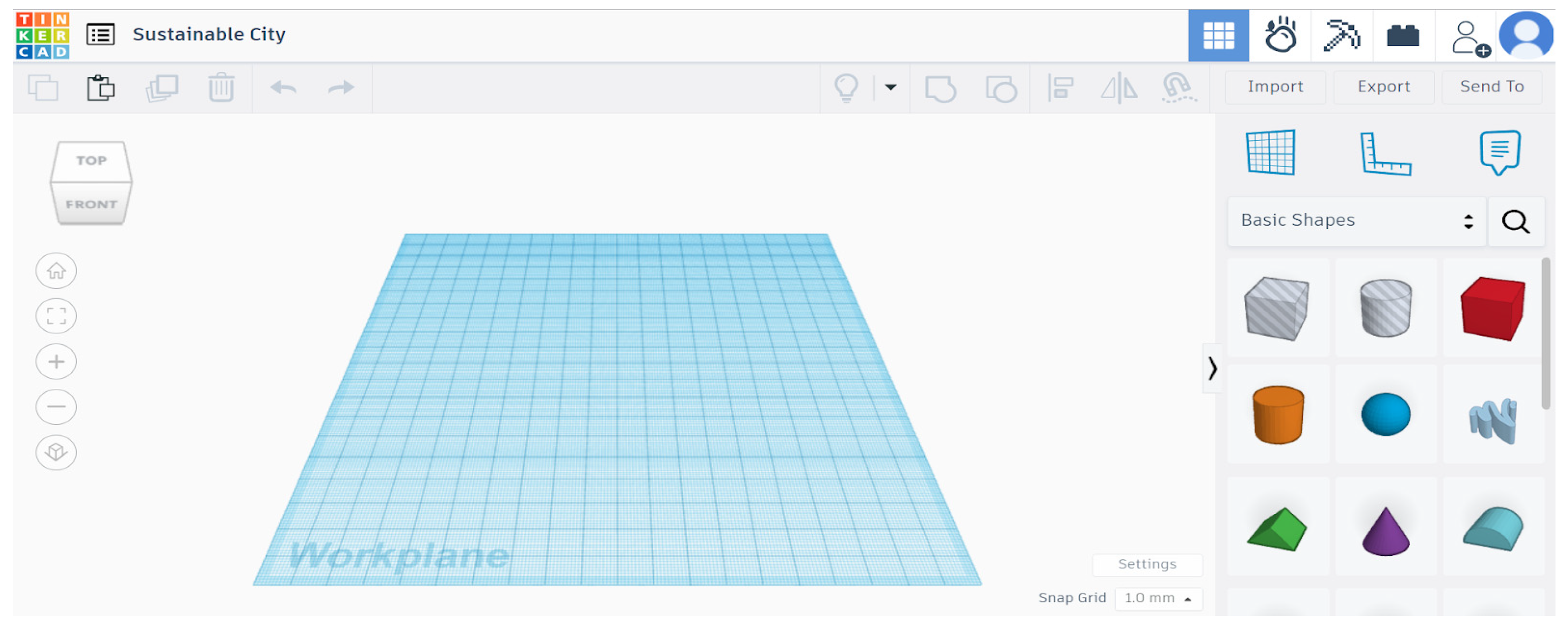
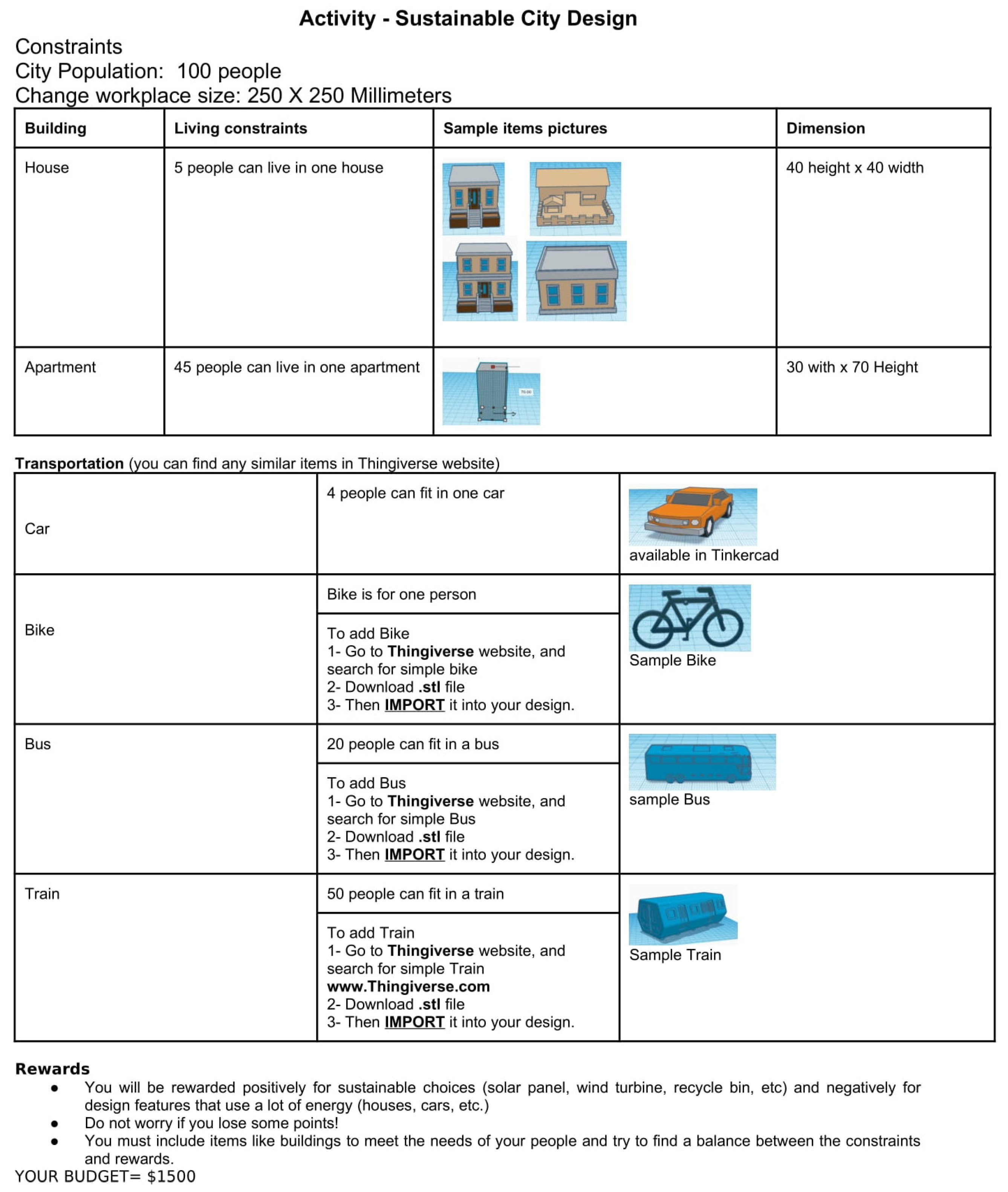
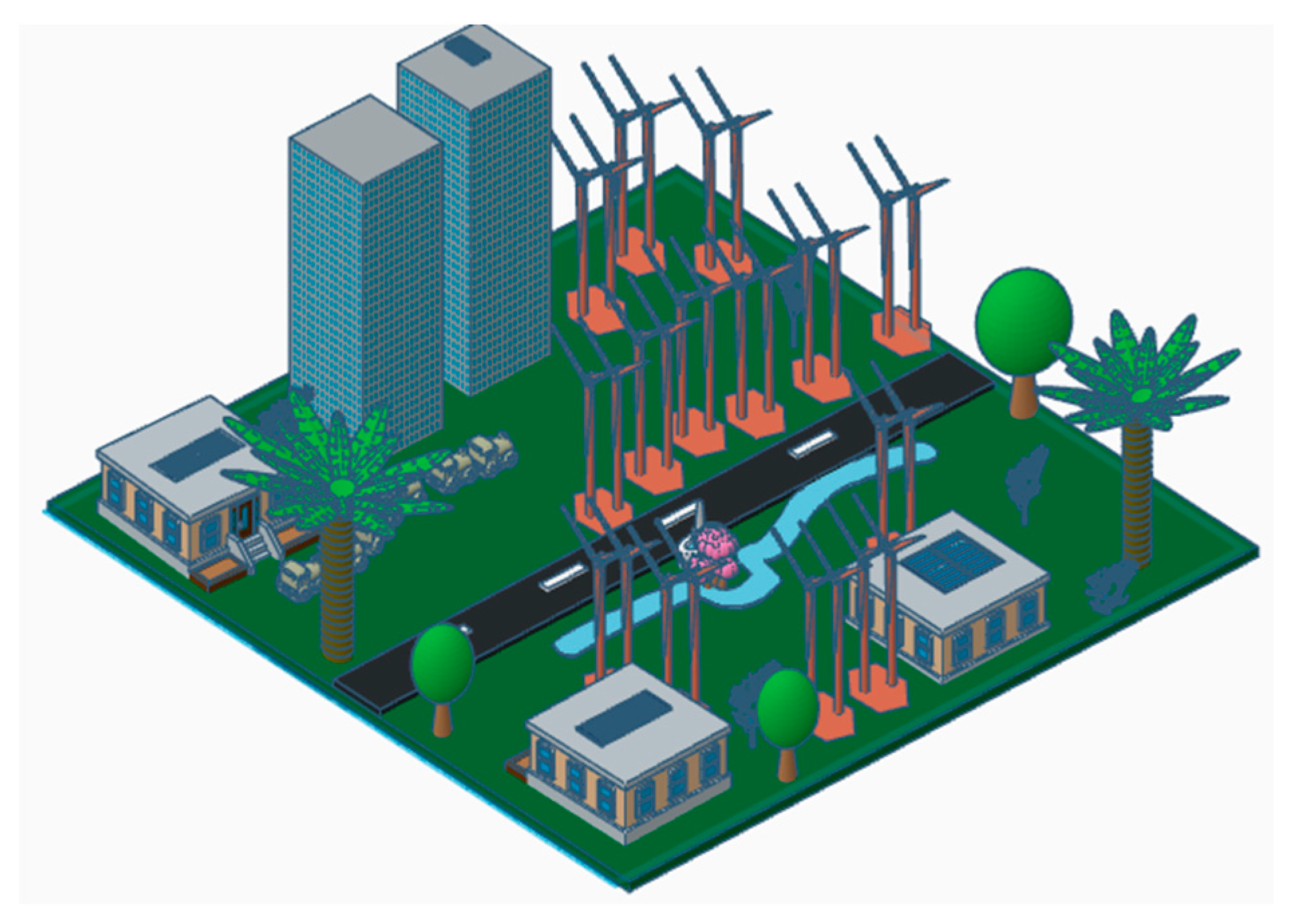

| Duration | Tools | Stages of the Design |
|---|---|---|
| Phase 1 (approximately two weeks) | #1—One iPad per dyad #2— MERGE Cube #3—CoSpaces Edu #4—Paper and colored pens, video about sustainability, presentation slides |
|
| Phase 2 (approximately two weeks) | #1—One touchable laptop and iPad per dyad #2— MERGE Cube #3—CoSpaces Edu #4—Pens, paper, presentation slides, point system per dyad |
|
| Phase 3 (approximately three weeks) | #1—One touchable laptop and iPad per dyad to design #2— MERGE Cube #3—CoSpaces Edu #4—Pens, paper, point system per dyad |
|
| Elements | Points |
|---|---|
| Green Spaces | +100 |
| Bike | +10 |
| Tree | +200 |
| Windmills | +200 |
| Solar Panels | +100 |
| Bridges | +5 |
| Houses | −50 |
| Apartments | −100 |
| Other Buildings | −100 |
| Cars | −25 |
| Trains | −15 |
| Buses | −15 |
| If the downtown area is close to housing | +55 points |
| Decorative items (for ex: outdoor furniture like benches, sculptures, lampposts, etc.) | 0 point |
| Explore Sustainable Cities | |
|---|---|
| Name: My city: _________________ | |
Check off the items you are able to find. (Keep in mind that some of these may not exist in your city!):
| Questions:
|
| Plants (Fruit/Vegetable/Flower/Tree) | Animals (Cows/Sheep/Chicken) |
|---|---|
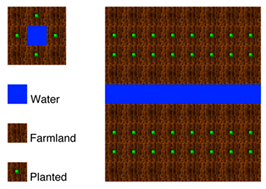 |  |
Items you can add to your farm
| |
| Elements | Cost | # | Total | Elements | Points | # | Total |
|---|---|---|---|---|---|---|---|
| Green Spaces | $50 | Green Spaces | +100 | ||||
| Green roofs | $15 | Green roof | +100 | ||||
| Pedestrian Walkways | $20 | Pedestrian Walkways | +30 | ||||
| Energy-Efficient Lighting | $20 | Energy-Efficient Lighting | +50 | ||||
| Bike | $5 | Bike | +10 | ||||
| Tree | $10 | Tree | +20 | ||||
| Wind turbine | $20 | Wind turbine | +200 | ||||
| Solar Panel | $25 | Solar Panel | +50 | ||||
| House | $50 | House | −50 | ||||
| Apartment | $100 | Apartment | −200 | ||||
| Other Building | $100 | Other Building | −100 | ||||
| Car | $10 | Car | −25 | ||||
| Train | $20 | Train | −10 | ||||
| Bus | $15 | Bus | −15 | ||||
| Total | Total |
| Greenhouse Curriculum | |
|---|---|
| Module # | Task Details |
| 1 | Introduction to micro:bit and MakeCode: Students practice block programming, connecting micro to Chromebooks, downloading applications, and programming LED strips in various colors and patterns. |
| 2 | Introduction to temperature and humidity sensors, OLED displays: Students start with reviewing plant science principles such as temperature and humidity, establishing variables, configuring data gathering functions, and showing real-time data on the OLED screen. |
| 3 | Greenhouse construction: Students work on assembling pieces, designing greenhouse details, and adding various devices inside and outside the greenhouses. |
| 4 | Introduction to data literacy: Students explore several data graphs, review their applications, program the micro:bit for data logging, export data to Google Sheets, and plot using CODAP. |
| 5 | Introduction to light Sensors and automation: Students learn how to detect light levels (lux) and then program a relay and light sensor to operate a light bulb using the data they acquired. |
| 6 | Setting up fans and relays: Students learn how to program in order to control airflow inside the greenhouse. |
| 7 | An open-ended scientific investigation: Students create research questions, configure the greenhouse, carry out experiments, and gather data to answer their questions. |
Disclaimer/Publisher’s Note: The statements, opinions and data contained in all publications are solely those of the individual author(s) and contributor(s) and not of MDPI and/or the editor(s). MDPI and/or the editor(s) disclaim responsibility for any injury to people or property resulting from any ideas, methods, instructions or products referred to in the content. |
© 2024 by the authors. Licensee MDPI, Basel, Switzerland. This article is an open access article distributed under the terms and conditions of the Creative Commons Attribution (CC BY) license (https://creativecommons.org/licenses/by/4.0/).
Share and Cite
Beheshti, M.; Shah, S.A.; Zhang, H.; Barnett, M.; Hira, A. Affordances of Technology for Sustainability-Oriented K–12 Informal Engineering Education. Sustainability 2024, 16, 6719. https://doi.org/10.3390/su16166719
Beheshti M, Shah SA, Zhang H, Barnett M, Hira A. Affordances of Technology for Sustainability-Oriented K–12 Informal Engineering Education. Sustainability. 2024; 16(16):6719. https://doi.org/10.3390/su16166719
Chicago/Turabian StyleBeheshti, Mobina, Sheikh Ahmad Shah, Helen Zhang, Michael Barnett, and Avneet Hira. 2024. "Affordances of Technology for Sustainability-Oriented K–12 Informal Engineering Education" Sustainability 16, no. 16: 6719. https://doi.org/10.3390/su16166719
APA StyleBeheshti, M., Shah, S. A., Zhang, H., Barnett, M., & Hira, A. (2024). Affordances of Technology for Sustainability-Oriented K–12 Informal Engineering Education. Sustainability, 16(16), 6719. https://doi.org/10.3390/su16166719






